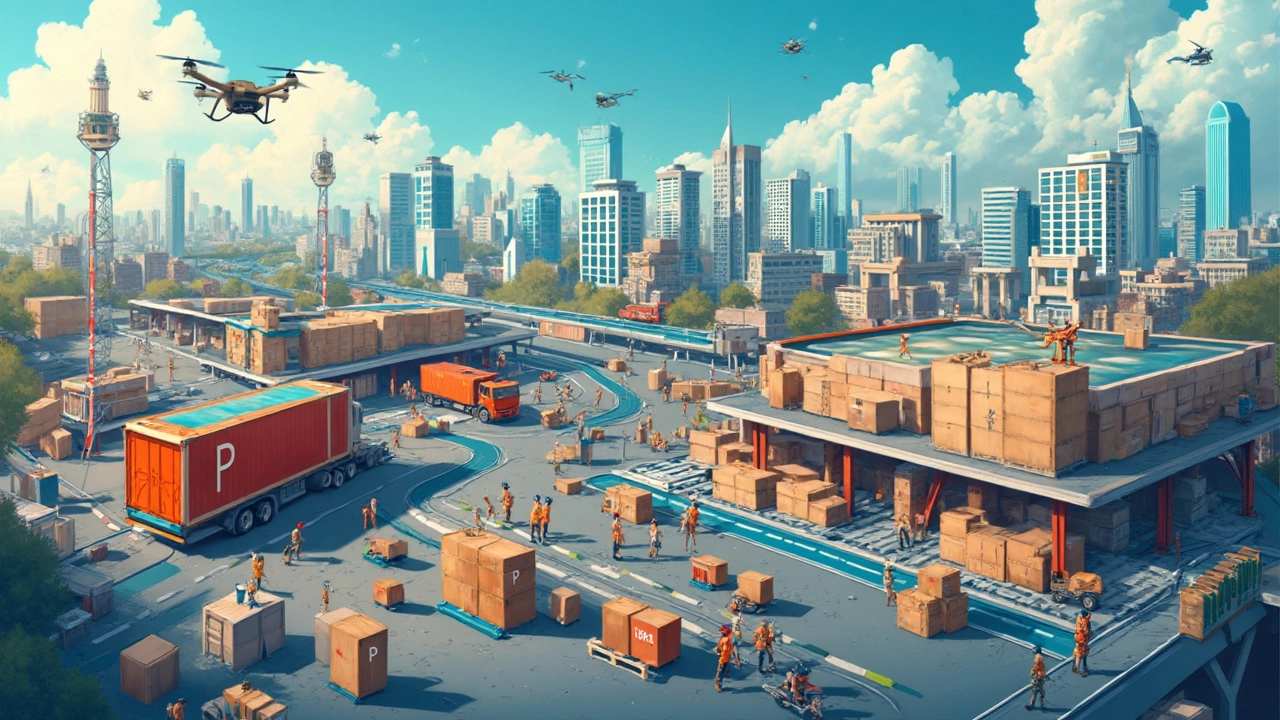When it comes to mastering logistics in the world of e-commerce, the magic lies in something called the 5 P's: Product, Price, Place, Promotion, and People. Each one plays a crucial role in steering the ship of your logistic operations. But why do they matter? Simply put, they are your roadmap to ensuring everything runs smoothly, from managing stock to getting products into customers' hands efficiently.
You know how frustrating it can be when a parcel doesn't arrive on time, right? That's why nailing down these 5 P's is important for keeping customers happy and coming back for more. In the e-commerce universe, your product has to hit the mark in quality and availability. Choose well, and you're already on the winning side.
- Introduction to the 5 P's
- Product: Choose Wisely
- Price: Find Balance
- Place: Strategic Location
- Promotion: Marketing Magic
- People: Key Players
Introduction to the 5 P's
Jumping into the fast-paced world of e-commerce, you'll quickly realize that logistics is your lifeline. It's not just about moving packages from A to B anymore. To stand out and thrive, you need to get savvy with what insiders call the 5 P's of logistics: Product, Price, Place, Promotion, and People.
Each 'P' is like a cog in a well-oiled machine, and overlooking any one of them can throw a wrench in your operations. According to recent reports, companies that master these elements see a significant reduction in delivery times and customer complaints. So, let’s break them down and see why they matter.
Product: The Heart of Logistics
Your product selection is the cornerstone of your logistics strategy. It doesn't matter how great your logistics are if you're selling the wrong products. Think quality, demand, and inventory—ensuring you're not sitting on obsolete stock.
Price: Navigating Costs
When it comes to pricing, striking that sweet spot between competitiveness and profitability is key. Overpricing might drive customers away, while underpricing can cut into your margins.
Place: Location and Distribution
Strategically chosen locations for your warehouses and distribution centers can make or break delivery efficiency. Being close to your main customer base cuts down on time and cost.
Promotion: Spreading the Word
Promotion is about more than just getting the word out. It’s about crafting campaigns that resonate with your audience and address logistics challenges upfront, like shipping times and costs.
People: Driving the Engine
The right team can elevate your logistics game. From skilled managers to tech-driven staff, it's people who implement strategies and troubleshoot problems.
As you can see, these 5 P's aren't just buzzwords; they form a crucial framework for any thriving e-commerce logistics operation. By keeping these principles in check, you're setting your business up for a smoother sail in the competitive market space.
Product: Choose Wisely
In the realm of e-commerce, choosing the right product is like picking the right tool for the job. It's the first step in setting up your logistics for success. Your selection can make or break your business, so it's crucial to be strategic from the get-go.
How do you start? Think market demand. A product that's in high demand is naturally easier to sell, reducing inventory headaches. Tap into current trends by using online tools to analyze what's hot. Just imagine the number of fidget spinners that flew off the shelves back in the day!
Price points matter too. Consider the cost of production and compare it to your projected sales price. You want to ensure a good margin without pricing yourself out of the market. Check what competitors are offering and see how you can provide better value.
If you're dealing in physical goods, don't forget about size and weight. These factors can dramatically impact shipping costs and logistics. Smaller, lighter items are easier and cheaper to store and ship, which can save you a ton down the line.
Quality Assurance
Making sure your product lives up to expectations is non-negotiable. Quality should always be a priority because one bad review can affect your business faster than you'd expect. Be certain your suppliers meet necessary standards and that you test samples before committing to larger orders.
Inventory Management
Keep an eye on inventory levels. Overstocking can clog up your storage, while understocking can lead to missed opportunities and unhappy customers. An efficient inventory management system can help you keep track of what's going in and out.
| Product Aspect | Importance |
|---|---|
| Market Demand | High |
| Quality | Very High |
| Cost to Ship | Medium |
Remember, your product choice isn't just about what you're passionate about; it's about what will resonate with your audience while keeping logistics running smoothly. Get this right, and you're in a solid position to tackle the rest of the 5 P's with confidence.
Price: Find Balance
In the world of e-commerce logistics, finding the right price is like walking a tightrope. Too high, and you scare away potential buyers; too low, and you're cutting into your profits. So, how do you strike that perfect balance?
Understand Your Costs
First off, you need a clear grasp of all your costs. We're talking everything from storage fees and shipping costs to packaging and even the occasional return. Knowing these numbers helps you set a price that's both competitive and profitable.
Competitive Pricing
Take a look at what your competitors are doing. Are they charging more or less for similar products? Tools like PriceSpy can give you a hand in keeping tabs on the competition. This way, you can position yourself strategically within the market, neither underselling nor overshooting.
Value Perception
Remember, pricing isn't just about numbers; it's also about how your customers perceive value. Sometimes, a slightly higher price can suggest better quality or more exclusive service, making it more appealing to certain buyers. Think Apple—people pay more because they believe it's worth it.
Discount Strategies
Discounts can be great for quick sales, but don't go overboard. Offer them on special occasions—like Black Friday or a site's anniversary—to boost customer interest without depleting your margins.
Here's a quick look at what could happen if you mishandle pricing:
| Scenario | Impact |
|---|---|
| Overpricing | Reduced sales, increase in abandoned carts |
| Underpricing | Erosion of profits, unsustainable operations |
| Right Pricing | Steady sales, loyal customers |
Finding that sweet pricing spot isn't a one-time task. It's a dance of constant adjustments, always keeping an eye on your costs, your rivals, and what your customers are willing to pay. Logistics success is as dependent on good pricing strategies as it is on managing the actual flow of goods.

Place: Strategic Location
When you run an e-commerce store, where you position your inventory can make or break your logistics game. So, what's the big deal about location? Simple. Being closer to your customers slashes delivery times and costs, making everyone happier. Think of it as a game of chess: you want your pieces in the best spots to win the game.
Now, more than ever, having a strategic hub or multiple locations isn't just nice to have—it's essential. This is where knowing your customer base pays off. Is most of your audience in the UK? Perhaps setting up in or near big cities like Liverpool or London could give you a logistics edge.
Proximity Equals Speed
The closer your products are to a major shipping area, the faster they get to your customer—it's that straightforward. In today's fast-paced market, speed is king, and a smart location strategy fuels that need for speed. No one wants to wait a week for what can arrive in two days.
Weighing Costs Versus Benefits
Of course, setting up a strategic location doesn't come for free. Rent can be pricey in prime spots. So, how do you balance it? Look at the trade-off between the cost of a location and potential savings in shipping and improved customer satisfaction. In some cases, partnering with a 3PL (Third-Party Logistics provider) might give you access to their network of warehouses without heavy price tags.
Interesting Fact: Location and Tech
Here's something cool: with the rise of tools like AI and big data, you can analyze customer behavior to predict the best locations for your warehouses. This data-driven approach can position you ahead of competitors.
The Power of Flexibility
Lastly, consider a flexible approach to your inventory locations. The e-commerce landscape is always changing, and what works today might not work tomorrow. Being able to adapt your strategy and, if needed, change locations quickly can keep you nimble and efficient.
Promotion: Marketing Magic
Promotion is like the secret sauce that can give your e-commerce business a real boost. Imagine creating a buzz around your products so loud that everyone knows your name. This isn't just about flashy ads but smart strategies that build brand loyalty and boost sales.
Crafting Compelling Campaigns
Successful promotions often start with understanding your audience. Know what makes them tick and design campaigns that hit their sweet spots. For instance, running targeted ads on social media platforms like Instagram or TikTok, where your audience hangs out, can result in soaring engagement levels.
Offers and Discounts
Who doesn't like a good deal? Promotions often revolve around offers and discounts that entice customers. Flash sales or limited-time discounts can create urgency, pushing potential buyers to click the 'buy' button faster. Just remember, promotions need to be planned wisely, so you’re not slashing prices too much. Here's a simple trick: Use discounts strategically during off-peak seasons to maintain sales momentum.
Influencer Collaborations
In today's influencer-driven market, teaming up with online personalities can do wonders for spreading the word. A well-chosen influencer can introduce your product to a broader audience, potentially leading to increased traffic and sales on your site. Be sure to select someone whose audience matches your target demographic for maximum impact.
Email Marketing
Email marketing might seem a bit old-school, but it’s still a heavy hitter in the promotion toolkit. Regular newsletters packed with info about upcoming products, tips, or special offers can nurture existing customer relationships and encourage repeat purchases.
Using Data to Optimize
Data is your best friend when it comes to fine-tuning promotions. Keep an eye on open rates, click-throughs, and conversion stats. Understanding what's working can help you tweak strategies in real-time. For instance, you could A/B test different promotional messages to see which one resonates better with your audience.
People: Key Players
In the e-commerce logistics world, tech and software might steal the spotlight, but it's the people behind the scenes who make everything tick. They ensure operations remain seamless, from managing logistics to handling customer interactions, and they bring a human touch to what could otherwise be a fully automated process.
Why People Matter
Logistics is all about precision, and who better to keep things precise than experienced staff? They maintain the balance of supply chain efficiency and customer satisfaction. Staff in warehouses pick and pack goods, delivery drivers ensure packages arrive on time, and customer service teams handle inquiries or any hiccups.
Skills and Responsibilities
Success in e-commerce requires staff who are not only skilled but also adaptable. The industry's fast pace means roles can change, and everyone from warehouse staff to managers needs to be on their toes.
- Warehouse Staff: Responsible for inventory management, picking, packing, and shipping.
- Delivery Drivers: Deliver goods efficiently, often serving as the face of the company.
- Customer Service Agents: Resolve issues, process returns, and provide support.
Building a Strong Team
Finding and keeping the right people begins with recruitment. Offer training programs to support growth and retention. Employees who understand their roles will contribute more effectively to your operations.
Consider this: according to a 2023 logistics report, companies with high employee satisfaction levels showed a 24% increase in efficiency and 32% lower turnover rates. Investing in your team pays off!
Technology's Role
While technology aids logistics processes—through automation and software—it's the people who manage these tools and interpret data. Investing in training for tech literacy is crucial.
To wrap it up, whether it's keeping warehouse operations smooth or ensuring customers get their parcels in perfect condition, people truly are key players in logistics. Without them, even the best technology would fall short.


